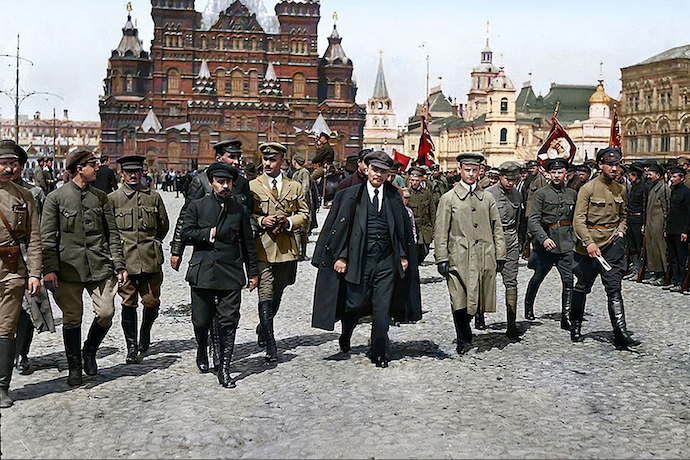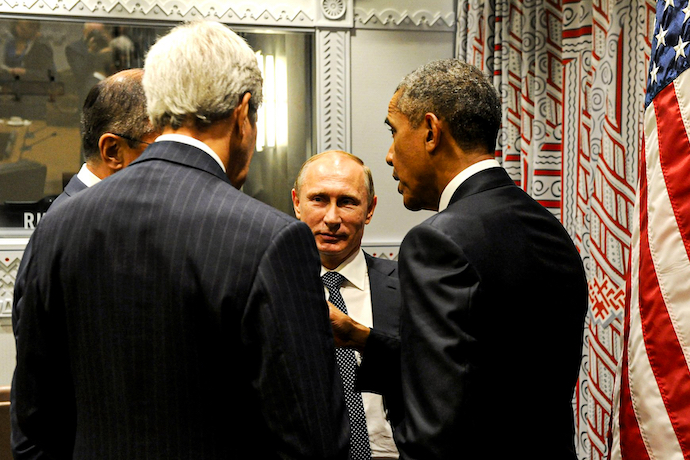
Politicians are Dreamers…Not Visionaries
A visionary is someone who possesses insight and foresight: politicians are known for neither. After the Cold War, a mindset of the U.S. vs Russia need not have occurred. Miscalculations fostered missteps which got us where we are today–which is not a good place to be.
It is difficult to imagine a period since the end of the Cold War when relations between Moscow and Washington have been quite so contentious. And that makes for international peril. Without some basic level of diplomatic trust and understanding between them, any dialogue rests upon an unstable foundation. With the Cold War at an end for over 30 years, how is it that the U.S. still perceives Russia as a threat?
This essay illustrates what some scholars suggest were rather shortsighted political miscalculations in the West’s response to Russia after “the Wall” fell in ‘89. Through hegemonic reasoning, a bit of collusion, and effective propaganda, NATO leaders set the stage for what we have today, a U.S.-led proxy war with Moscow.
This piece further addresses how a Cold War-era propaganda campaign continues to exacerbate the effects of these missteps well beyond the close of that era.
One issue of critical pivotal concern is NATO. Its expansion eastward is seen by Russia as directed against that country’s security interests. Vladimir Putin, Russia’s authoritarian president, has been clear for decades that if continued, the expansion would likely be met with serious resistance by the Kremlin, perhaps even a military response.

And Moscow is not alone in its concerns. There are influential American foreign policy experts who have given credence to Russia’s concerns and the idea of Western political miscalculations.
Biden’s CIA director, William J. Burns, has been warning about the provocative effect of NATO expansion towards Russia’s borders since 1995. That’s when Burns, then a political officer in the U.S. Embassy in Moscow, reported to Washington that “hostility to early NATO expansion is almost universally felt across the domestic political spectrum here.”
In 1999, the Clinton administration moved to bring Poland, Hungary, and the Czech Republic into NATO. Burns wrote in response that the decision was “premature at best, and needlessly provocative at worst.” He continued, “As Russians stewed in their grievance and sense of disadvantage, a gathering storm of ‘stab in the back’ theories slowly swirled, leaving a mark on Russia’s relations with the West that would linger for decades.”
In June 1997, two years before Poland, Hungary, and the Czech Republic joined NATO, 50 prominent foreign policy experts signed an open letter to Clinton, saying: “We believe that the current U.S. led effort to expand NATO…is a policy error of historic proportions” that will “unsettle European stability.”
In 2008, Burns, then the American ambassador to Moscow, wrote to Secretary of State Condoleezza Rice: “Ukrainian entry into NATO is the brightest of all redlines for the Russian elite (not just Putin). In more than two and a half years of conversations with key Russian players, from knuckle-draggers in the dark recesses of the Kremlin to Putin’s sharpest liberal critics, I have yet to find anyone who views Ukraine in NATO as anything other than a direct challenge to Russian interests.”
Former CIA officer and non-resident senior fellow at Georgetown University’s Center for Security Studies, Paul R. Pillar, shared Director Burn’s concerns and blamed the West for precipitating the current problem: “The relationship went wrong when the West did not treat Russia as a nation that had shaken off Soviet Communism,” Pillar has said. “It should have been welcomed as such into a new community of nations – but instead it was regarded as the successor state of the USSR, inheriting its status as the principal focus of Western distrust.”
These scholars suggest that NATO’s rather “tone‐deaf” policy toward Russia over the past quarter‐century deserves a measure of responsibility for the difficult geopolitical issues confronting the world today. Analysts committed to a U.S. foreign policy of realism and restraint have been particularly expressive. Their counsel has been clear: continuing to expand NATO (the most powerful military alliance in history toward another major power) would not end well. The war in Ukraine provides definitive confirmation that these voices have merit.
There is valid, well-documented evidence that NATO leaders were not forthcoming with the “Russian Bear” since the Cold War ended. Promises were made but never kept. Assurances were given–but by people with short memories.
U.S. Secretary of State James Baker’s famous “not one inch eastward” assurance about NATO expansion in his meeting with Soviet leader Mikhail Gorbachev on February 9, 1990, was part of a cascade of assurances about Soviet security. Gorbachev and other Soviet officials received reiteration of these assurances throughout the process of German reunification in 1990 and 1991. Declassified U.S., Soviet, German, British, and French documents posted on December 12, 2017 by the National Security Archive at George Washington University attest to this.

There appears to be a structural fallacy in the West’s orientation vis-à-vis Russia, today. The view of the USSR as a threat during the Cold War was valid. The Warsaw Pact was real and its purpose was clear. Today, however, not even the Russian president sees Russia as a threat to the EU or NATO. Putin explained his reasoning during an interview with conservative journalist Tucker Carlson, in early February.
President Putin cites Otto von Bismarck approvingly for identifying the “potentials” of nations as the “most important” factor in assessing conventional military capabilities. The president uses two parameters to assess “potential”: the size of the economy and the size of the population. According to the reasoning of the Russian president, it is these two pillars which constitute the basis upon which a country’s military prowess should be assessed, and compared to the EU and NATO, Russia is no threat.
If we apply this thought process to the possible outcome of a conflict between Russia and Europe, the results are telling. Using the same criteria as Putin, the math is quite straightforward. Russia has a population of 144 million; the EU and the UK combined is over 448 million. The PPP-GDP of Russia is roughly $5 trillion; that of the EU+UK combined is roughly $30 trillion. These numbers place Russia in a most unenviable position concerning a conflict with Europe.
A comparison with the whole of NATO leaves Russia in an even worse position. The population of NATO is 960 million; over six times larger than Russia. NATO’s PPP-GDP is a bit over $50 trillion, 10 times that of Russia. Moreover, NATO has a total of 3.4 million military personnel; Russia has 1.15 million with a plan to expand to 1.5 million by 2026. The reality is in the numbers, and even the Russian president sees that in a conventional conflict, Russia does not measure up.
Concerning the use of nuclear weapons, Putin is equally clear: “It is absolutely out of the question. You just don’t have to be any kind of analyst; it goes against common sense to get involved in some kind of global war. And a global war will bring all of humanity to the brink of destruction. It’s obvious.”
We are led, ineluctably, to one conclusion: that the fallacy spoken of is without grounds. Russia cannot prevail against the West in a conventional conflict, and, by Putin’s reckoning, a nuclear exchange is unthinkable. Russia has no advantage in either scenario.
Thus, it would appear that maintaining economic and political hegemony is what has been driving the decisions of Western leaders since the Cold War ended. Maintaining a perceived necessity for NATO’s existence was part of that miscalculation–Russia as a threat was needed to achieve that perception.
It seems that for many Western leaders, the Cold War never ended–they couldn’t allow that.
If political dynamics was the salient feature in the drama just presented, circumstances could conceivably be altered–changes in leadership are politically inevitable. Politicians come and go, and so do ideas and priorities. But the situation is more involved than this. There is another more insidious undercurrent which augments the idea of Russia as a threat, NATO expansion, and the Ukraine proxy war: manufactured consent.
In 1921, Sigmund Freud explored in his work, Group Psychology and the Analysis of the Ego, the extent to which instinctive group psychology could affect rational thinking. Ironically, Freud’s ideas were further developed by his nephew, Edward Bernays, who, perhaps unfortunately for all of us, became the father of modern political propaganda.
Over a century ago, Walter Lippman and more recently, Ed Herman and Noam Chomsky, cautioned us about group psychology managed with propaganda–it comes with a heavy price. Yielding to our instinctual demands of viewing conflict as a struggle between the virtuous “us” versus the evil “them” implies a single-minded approach to conflict resolution. With this view, peace requires defeating one’s adversary, while efforts at a workable solution become tantamount to appeasement. Surrendering to these alternatives is a false dichotomy, an either/or choice–and that is both unnecessary and dangerous. To do so is to remain trapped, psychologically, in a 1940s mindset, where an adversary must be defeated and not appeased with no gray area between them.
NATO leadership and mainstream media in the West are representative of what Ed Herman and Noam Chomsky (Manufacturing Consent) and Walter Lippmann (Public Opinion) refer to in their seminal texts: the manufacture of consent through propaganda and the danger it creates when misused or overused.
Newton’s first law of motion, the principle of inertia, says something will remain at rest or in motion until acted upon by a force causing it to deviate from its path. The world can afford neither the inertia of some of today’s dangerous foreign policy initiatives nor the propaganda machines that perpetuate them. The risks are too great for further miscalculation.

